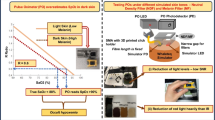Abstract
Objective.There is no commonly accepted in vivocalibration method for pulse oximeters available up to now. On the basis of a prototype device for the calibration of pulse oximeters which was introduced recently, a second approach based on the same concept was tackled in order to design a reliable method for standardized calibration of pulse oximeters. Methods.An extensive clinical database of time-resolved optical transmission spectra of patient fingers is used to simulate the behavior of patients. A device which is capable of playing back these spectroscopic data to pulse oximeters, and a database where the oxygen status measured with the reference method (Co-Oximetry) is stored, are the main parts of the concept. The playback device has an artificial finger as interface to the pulse oximeters and serves to collect light from the pulse oximeter for analysis and to playback simulated light to the pulse oximeter. The light intensity emitted by two LEDs which illuminates the pulse oximeter detector is controlled via a computer in such a way that it is the same as if the pulse oximeter light had passed the finger. The pulse oximeter display during the data playback can thus be compared to the true SaO2 of the patient. The device is tested with 4 pulse oximeters based on 100 patient spectra. Results.For the four pulse oximeters used in this investigation, an Agilent Technologies CMS monitor (formerly Hewlett-Packard), an Ivy 2000 with Masimo SetTM technology and Nellcor N-3000 and N-395, there is good correlation between SpO2 and SaO2, and mean and standard deviation of in vivoSpO2-SaO2 and playback SpO2-SaO2 are in good agreement. For two instruments, Nellcor N3000 and Agilent CMS Monitor, a quantitative comparison between the in vivoand in vitroSpO2 results was derived. A mean of the deviation playback vs. in vivoSpO2 is less than 0.5% SpO2. The error limits are comparable with the calibration error of the conventional calibration routine. The device is also capable of data playback even in situations with rapid desaturation changes, as displayed in Figure 2. For the other tested pulse oximeters the results are comparable. Conclusions.Compared to the first prototype the current version is simpler and less expensive in production. Many of previously existing problems are solved and the applicability to a large variety of pulse oximeters and sensors is given. The novel concept for the calibration of pulse oximeters is a tool for assessing the performance of pulse oximeters.
Similar content being viewed by others
REFERENCES
Yelderman M, New W. Evaluation of pulse oximetry. Anesthesiology 1983; 58: 349–352
Severinghaus JW, Naifeh KH. Accuracy of response of six pulse oximeters to profound hypoxia. Anesthesiology 1987; 67: 551–558
Munley AJ, Sik MJ, Shaw A. A test object for assessing pulse oximeters. Lancet 1989; i: 1048–1049
Reynolds KJ, Moyle JTB, Gale LB, Sykes MK, Hahn CEW. In vitro performance test system for pulse oximeters. Med Biol Eng 1992; 30: 629–635
Zhou GX, Schmitt JM, Walker EC. Electro-optical simulator for pulse oximeters. Med & Biol Eng Comput 1993; 31: 534–539
Volgyesi G, Kolesar R, Lerman J. An in vitro model for evaluating the accuracy of pulse oximeters. Can J Anaest 1990; 37 (suppl): 67
Shind Y, Fuse M, Aoyagi M. Apparatus for calibrating pulse oximeters. Unites States Patent No. 5, 278,627
Barker JS, Shah Nk. The effects of motion on the performance of pulse oximeters in volunteers (revised publication). Anesthesiology 1997; 86 (3): 101–108
Gehring H, Hornberger Ch, Matz H, Schäfer R, Konecny E, Schmucker P. The bias and precision of a new generation of pulse oximeters. Respiratory Care 2000; 45: 993
Marble DR, Burns DH. Pulse oximeter simulator. Technical report, U.S. Food & Drug Administration, Center for Devices and Radiological Health, Office of Science & Technology (HFZ-141), 12720 Twinbrook Parkway, Rockville, MD 20587, U.S.A., 1993, Project officer: Dr. Sandy Weininger, 1993.
Hornberger Ch, Knoop Ph, Nahm W, Matz H, Konecny E, Gehring H, Bonk R, Frankenberger H, Mayfroidt G, Wouters P, Gil-Rodriguez J, Ponz L, Benekos K, Valais J, Avgerinos J, Karoutis A, Ikiades A, Weininger S. A prototype device for standardized calibration of pulse oximeters. J Clin Monit 2000; 16–3: 161–169
Author information
Authors and Affiliations
Rights and permissions
About this article
Cite this article
Hornberger, C., Knoop, P., Matz, H. et al. A Prototype Device for Standardized Calibration of Pulse Oximeters II. J Clin Monit Comput 17, 203–209 (2002). https://doi.org/10.1023/A:1020795307742
Issue Date:
DOI: https://doi.org/10.1023/A:1020795307742




